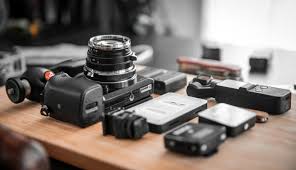Must-Have Photography Gear for Travel Enthusiasts.
Must-Have Photography Gear for Travel Enthusiasts.

Travel photography is an incredible way to capture memories, tell stories, and share the beauty of the world through your lens. Whether you’re wandering through bustling city streets, hiking remote trails, or relaxing on a pristine beach, having the right photography equipment can make all the difference in the quality and creativity of your shots. But with so many gadgets and accessories on the market, deciding what to bring can be overwhelming.
This guide will walk you through the essential photography gear every travel enthusiast should consider packing. We’ll cover everything from cameras to accessories, helping you prepare for your next adventure with confidence and creativity.
Choosing the Right Camera for Travel
Your camera is the centerpiece of your photography kit, and selecting one that suits your travel style is critical.
Mirrorless Cameras
Mirrorless cameras have become increasingly popular due to their compact size and excellent image quality. They provide interchangeable lenses and advanced features without the bulk of traditional DSLRs. Many mirrorless models are weather-sealed and offer fast autofocus, ideal for capturing spontaneous moments on the go.
DSLR Cameras
Digital Single-Lens Reflex (DSLR) cameras are favored by many professionals for their robust build and extensive lens selections. While typically heavier than mirrorless cameras, DSLRs often offer longer battery life and superior ergonomics, which can be beneficial for extended shooting sessions.
Compact Cameras and Smartphones
For travelers who prefer minimal gear, high-end compact cameras or the latest smartphones can produce outstanding images. These devices excel in convenience and are great for casual photography or social media sharing. Advanced smartphones now feature multiple lenses and computational photography for impressive results.
Essential Lenses to Pack
Lenses shape your photographic possibilities. Bringing the right selection lets you adapt to varied scenarios.
- Wide-Angle Lens: Perfect for landscapes, architecture, and interiors. A focal length around 16-35mm captures sweeping vistas and tight spaces.
- Standard Zoom Lens: An all-purpose lens, often in the 24-70mm range, useful for street photography and portraits.
- Telephoto Lens: For wildlife, sports, or distant subjects, a zoom lens around 70-200mm or longer helps you get close without disturbing your scene.
- Prime Lens: Lightweight and sharp, prime lenses like 35mm or 50mm are ideal for low light and creative depth of field effects.
Many travel photographers opt for versatile zoom lenses to minimize weight and bulk.
Tripods and Stabilization Tools
A sturdy tripod can dramatically improve your photo quality, especially in low light or when capturing long exposures.
- Travel Tripods: Compact and lightweight models made from carbon fiber or aluminum are perfect for portability.
- Monopods: Easier to carry and set up quickly, monopods offer some stabilization without the bulk of a full tripod.
- Gimbals and Stabilizers: For video or smooth motion shots, handheld gimbals stabilize your camera or smartphone.
Essential Accessories
Memory Cards and Storage
Always bring multiple high-capacity, fast-speed memory cards to avoid running out of storage. Carry a portable external hard drive or use cloud storage options for backups.
Extra Batteries and Chargers
Nothing ruins a shoot like a dead battery. Pack spare batteries and portable chargers, especially for long days without access to power.
Camera Bag or Backpack
A comfortable, weather-resistant bag keeps your gear organized and protected. Look for designs with customizable compartments and quick access pockets.
Lens Cleaning Kit
Dust, smudges, and moisture can ruin photos. Carry microfiber cloths, lens cleaning solution, and air blowers to keep your lenses pristine.
Filters
- Polarizing Filters: Reduce glare and enhance sky and water colors.
- Neutral Density (ND) Filters: Allow longer exposures in bright conditions for creative effects like silky waterfalls.
Remote Shutter Release
Use a remote or intervalometer for sharp shots during long exposures or self-portraits.
Practical Tips for Travel Photography Gear
- Prioritize Lightweight Gear: You’ll be carrying your equipment often, so choose items that balance quality and portability.
- Customize Your Kit: Tailor your gear to your destination and shooting style. For example, urban travel may require compact lenses, while nature trips benefit from telephoto reach.
- Protect Your Equipment: Use rain covers, padded cases, and weather-sealed gear to protect against dust, moisture, and bumps.
- Know Your Gear: Familiarize yourself with your camera’s settings and features to maximize shooting opportunities and reduce missed shots.
Enhancing Your Travel Photography Experience
Plan Ahead
Research your destination for unique photo opportunities and the best times for natural light. Early mornings and late afternoons often provide soft, golden lighting.
Practice Composition Techniques
Learn about rule of thirds, leading lines, framing, and symmetry to create visually compelling images.
Experiment with Settings
Try different apertures, shutter speeds, and ISO settings to capture motion, depth, or texture creatively.
Backup Your Photos Regularly
Avoid losing precious images by backing up files daily, either to a laptop, external drive, or cloud services.
Conclusion
Travel photography is a rewarding way to immortalize your adventures and express your artistic vision. Having the right gear tailored to your needs not only enhances image quality but also makes your trips more enjoyable and less cumbersome.
By selecting a suitable camera, versatile lenses, reliable stabilization, and practical accessories, you equip yourself to capture stunning moments across diverse environments. Remember, the best camera is the one you have with you — and with thoughtful preparation, that camera will be ready to tell your unique travel story wherever your journey leads.


